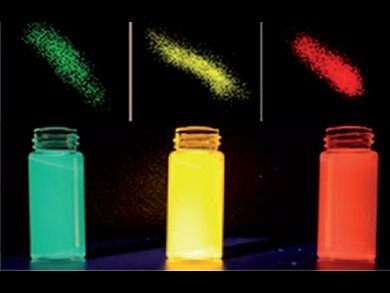Multicolored highly fluorescent silicon nanowires show potential in optoelectronic and biological applications because of their excellent aqueous dispersibility, strong photoluminescence, and high photostability.
The synthesis of fluorescent silicon nanowires by a one-pot, microwave-assisted strategy (see figure a) has been reported by collaborators from Soochow University and the City University of Hong Kong, both in China. These nanowires are decorated with red-, yellow, or green-emitting quantum dots (QDs), which makes them highly fluorescent (see figure b). The nanowires show excellent aqueous dispersibility, strong photoluminescence (quantum yield of ca. 30–35 %), and high photostability which are all important properties for long-term and real-time cellular imaging applications.
![]()
Images: (c) Wiley-VCH
- Highly Luminescent Water-Dispersible Silicon Nanowires for Long-Term Immunofluorescent Cellular Imaging
Y. He, Y. Zhong, F. Peng, X. Wei, Y. Su, S. Su, W. Gu, L. Liao, S.-T. Lee,
Angew. Chem. Int. Ed. 2011.
DOI: 10.1002/anie.201100482 - Y. He, Y. Zhong, F. Peng, X. Wei, Y. Su, S. Su, W. Gu, L. Liao, S.-T. Lee,
Angew. Chem. 2011.
DOI: 10.1002/ange.201100482




